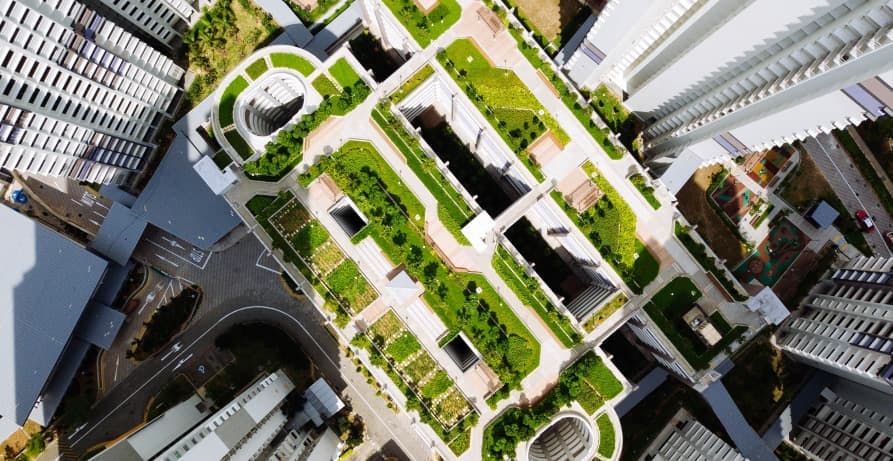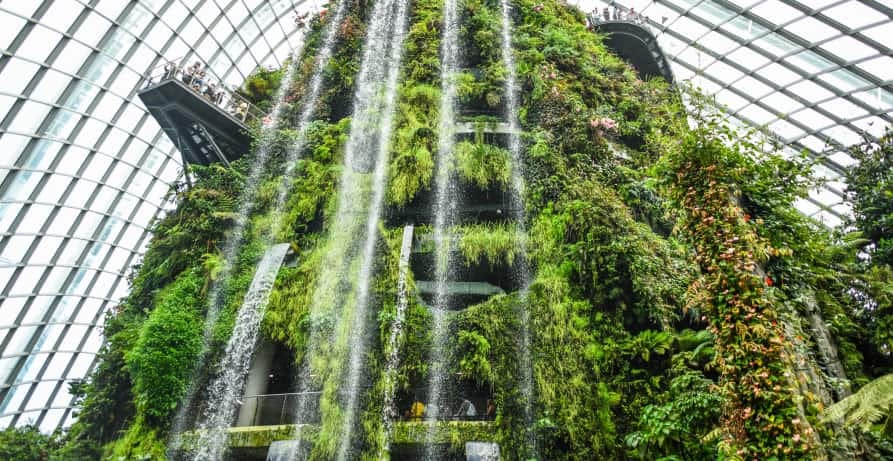
The UK’s Transport Decarbonisation Plan: Everything you need to know
In this article, we’ll unpack the key details of the UK’s Transport Decarbonisation Plan and what it means for the transport industry.
ESG / CSR
Industries



Green building uses design and planning strategies to reduce the harmful impacts of buildings on the environment. These strategies are not only attractive to property investors, but also beneficial to the health and cost efficiency of building occupants.
Buildings have an immense impact on the environment. Let’s break these impacts down into specific categories:
According to the World Green Building Council, a “green building” reduces the potential environmental harm and improves the environmental benefits it creates throughout its lifecycle. This starts with building design and continues through construction, operation and occupation, renovation, and demolition.
A wide-range of variables factor into green building design and construction. A lot of these variables are context-specific to its plot, neighborhood, and climatic region.

Every aspect of a building can be optimized for energy-efficiency, zero-waste, and resiliency in the design principles.
Here are some examples of green building features:
1. Building materials: Building with reused, recycled, biodegradable, or carbon storing materials are used in many green buildings.
2. Emissions reduction: Green buildings make use of renewable energy sources such as rooftop solar and a smart grid, heat pumps for heating and cooling, and solar water heaters.
3. Temperature control: Insulation, cool roofs, solar shading, double paned windows, window glazing are used in green buildings.
4. Flood and storm risk mitigation: Elevated building, planting trees or hedges for windbreaks, installing detention tanks for stormwater, permeable surfaces for water absorption into the ground.
5. Energy efficiency: Natural lighting and ventilation, smart meters, ENERGY STAR rated appliances, LED lights, sensors for powering off electric appliances, lights, or devices are often used in green buildings.
6. Water use: Low flow toilets, smart meters, rainwater harvesting are often incorporated into green buildings to help reduce water usage.
7. Waste reduction: Compost, zero waste design, grey water recycling are often integrated into green buildings.
8. Social and cultural value: Accessibility, local art or design, community event spaces, educational design, modular spaces, noise and light pollution reduction.
9. Landscape and biodiversity: Vertical gardens, rooftop gardens, permeable design features, bird-friendly design.
10. Make use of renewable energy sources: Many green buildings make use of renewable energy sources such as solar panels or wind turbines to provide on-site sustainable power and during construction of green buildings themselves.
All of the design features of a green building help to “future proof” it from the risks of climate change and resource scarcity. At the same time, green building principles benefit occupants’ health and well being while providing cost savings.
Here are some more reasons why committing to the construction of a green building isn't such a bad idea:
Solving sustainability challenges at the building-level is the start to creating scalable solutions at the community level. Buildings can serve as important landmarks that represent a new way of doing things.
For example, Singapore’s “green buildings” featuring high-tech vertical gardens and circular design principles have become world-famous emblems for a more sustainable future. In 2021, Climate Week NYC was hosted at its newly renovated Javits Convention Center, boasting a green roof.
Apart from these high-end examples, it is also important to spread access to low-income communities to the benefits of green building. These communities have faced some of the worst consequences of pollution, while contributing to it the least. Private-public partnerships can help finance this access.
The green building sector is spurring design innovation for circularity, reuse, recycling and biodegradable materials. Examples include wood log structures that store carbon, bricks made of mycelium, and recycled textile bricks.
Concrete is one of the most widespread building materials, but recently the Guardian called it “the most destructive materials on earth.” From its production to its disposal, concrete causes 4-8% of global CO2 emissions and it is highly water intensive. That’s why companies are now creating sustainable concrete.
An estimated 3.8 million people die from premature deaths linked to indoor air pollution, according to the WHO. Considering Americans spend 90% of their time indoors, the indoor air quality is particularly important. The EPA estimates that indoor air pollution can exceed air pollution outdoors by 2 to 5 times.
👉 The sources of indoor air pollution include lead paint and pipes, asbestos, chemicals from cleaning products, mold, radon, smoke from combustion, and particulate matter. Recent studies also suggest that indoor gas-powered stove tops also contribute significantly to health risks.
Real estate investors are increasingly engaged in ESG activities, thanks to growing interest from institutional investors. GRESB is one of the largest ESG data providers in real estate with global benchmarks and assessment data for real estate investments around the world.
Investors can improve their ROI by implementing green building design features. Research shows that 73% of US homeowners would pay more for environmentally friendly homes. Multi-unit building owners also receive higher rent and occupancies from both LEED-certified and Energy Star rated buildings.
Building owners also significantly save costs by making energy, material, and resource-efficiency improvements to buildings. An energy audit can be a good place to start.

The characteristics of green buildings make them more cost effective, healthy to use, and supportive of their communities.
Energy efficiency is one of the hallmarks of green building, because it not only serves the environment, it greatly reduces costs for building owners. Building insulation, double-paned windows, and window placement, sun shading, and cool roofs can all minimize the heat and cooling costs of a building.
While green building certifications (explained below) often consider how design affects energy efficiency, operation can also play a huge role. Beyond the building design, owners should source energy-efficient appliances and minimize their use of electricity and energy with the help of smart thermostats.
Accomplishing the design aims of a building with the least amount of materials is one of the benefits of green building. Designers consider ways to minimize material excess and waste through careful building design and material sourcing and selection.
Circular design principles, which consider the overall impacts across a building project’s life cycle help designers to identify key areas of improvement such as incorporating recycled, reused, or biodegradable materials.
Architectural designs that consider the directional flow of air and sunlight help buildings harness nature for useful purposes. Why use electric fans, when the wind can distribute air throughout a building? Why use electric lighting during the daytime, when well-placed windows can welcome the light?
These design considerations are part of the holistic thinking that makes green building less dependent on technology. Designers weigh the pros and cons of environmental forces to enhance their benefits for people indoors.
Green buildings reduce the toxic materials and emissions from buildings. They also prioritize healthy ventilation and access to natural mood-boosting sunlight.
Buildings can improve their indoor air quality with air-purifying potted plants and ventilation systems, as well as removing the sources of air pollution by using non-toxic materials, cleaning agents, and electric stoves.
Green buildings may appear more valuable on the surface because of their benefits, but they actually depend on cost-effective approaches to building that reduce the financial burden on building owners.
👉 Savings come from strategies like reusing materials in renovation which improves cost in the short-term and embedding energy efficiency in the design, which saves on heating costs over the long-term.
Many regions also offer financing opportunities which incentivize green building strategies for developers or existing building owners. For example in the UK, grants of 5,000 GBP are available for homeowners to swap their old high emissions boilers with cleaner heating systems.
Buildings are a part of the community, and they contribute to the health and well-being of the surrounding area. When buildings emit pollution or strain their resources, they can have negative impacts on the broader communities.
Water stress is a particular concern, because a quarter of the world’s water basins used for freshwater reserves are stressed. Half of these fall in China, India, and the United states.
Urbanization is concentrating water stress risk in cities. The global population living in cities increased from 0.8 billion (29.97%) in 1950 to 4.4 billion (56.2%) in 2020. Building owners and managers can address this by educating building occupants and improving building water efficiency.
👉 Climate change is another risk that has a direct impact on buildings. The increasing frequency and intensity of storms and floods could make insurance less accessible or affordable in the future.
Buildings are also a part of the solution, because an estimated two-thirds of all greenhouse gas (GHG) emissions are generated in cities. Buildings are responsible for 40% of these emissions. Shifting reliance off gas heating with energy efficient heat pumps can significantly improve building emissions.

Green building certifications are available from third-party assessors. These certifications create standards to evaluate and benchmark performance for different building types.
The LEED green building rating system by the US Green Building Council (USGBC) was created in 2000 and has over 100,000 projects registered. Many city and state policies also call for LEED Certification.
The current version LEED v4 uses 11 categories to evaluate buildings: integrative thinking, energy, water, waste, materials, location and transportation, sustainable sites, health and human experience, regional impacts, innovation, and the use of standards (local, regional, and global).
LEED also evaluates a wide range of building project types: New Construction (NC), Existing Buildings, Operations & Maintenance (EB O&M), Commercial Interiors (CI), Core & Shell (CS), Schools (SCH), Retail, Healthcare (HC), Homes, Neighborhood Development (ND).
Buildings can earn up to 110 points and their merit is recognized in four levels: Certified, Silver, Gold, and Platinum. Buildings must pass mandatory prerequisites for certification, and they also earn credits for recognized sustainability strategies in use.
Created in 1990 by the Building Research Establishment (BRE), BREEAM is the world’s longest-standing building sustainability assessment method. It uses a five star rating system to holistically assess a building’s sustainability performance through on-site third party evaluations.
The nine categories considered by BREEAM are management, health and well-being, energy, transport, water, materials, waste, land use and ecology, and pollution.
Buildings must meet a minimum standard for their life-cycle stage and building type. BREEAM evaluates new construction, in-use buildings, renovation, communities, and infrastructure.
BREEAM has issued over 565,000 certificates in 80 countries around the world.
Energy Star offers building ratings for energy and water use in commercial real estate based on a benchmarking system that compares the relative efficiency for buildings by size and class. The rating system was created by the US EPA and DOE.
The Energy Star rating system uses a national survey, the Commercial Building Energy Consumption Survey (CBECS), which compiles data on commercial building characteristics every four years.
Buildings are scored by percentile, and a building needs to achieve a rating of at least 75, which indicates the building has better energy or water use than 75% of its peers, to earn an Energy Star rating.
Green Globes awards certification to buildings on a scale of one to four globes, with four being the highest rating. Led by the Green Building Initiative in the US and BOMA in Canada, the program provides guidance and assessment for new and existing buildings.
The overall assessment considers 1000 points and buildings can earn credits based on a total of seven criteria: energy, indoor environment, site, water, resources, emissions and project/environmental management.
If reading this article about a green building and the benefits of constructing a green building has made you interested in reducing your carbon emissions to further fight against climate change – Greenly can help you!
Greenly offers businesses a practical way to explore the environmental impacts of their decisions using a digital platform. From building operations to transportation technologies, we can help you identify which changes could have the biggest positive impact for issues like CO2 emissions.
For businesses that care about improving sustainability through green building opportunities and other approaches, Greenly is here to help. We offer guidance and support at all stages of your journey.